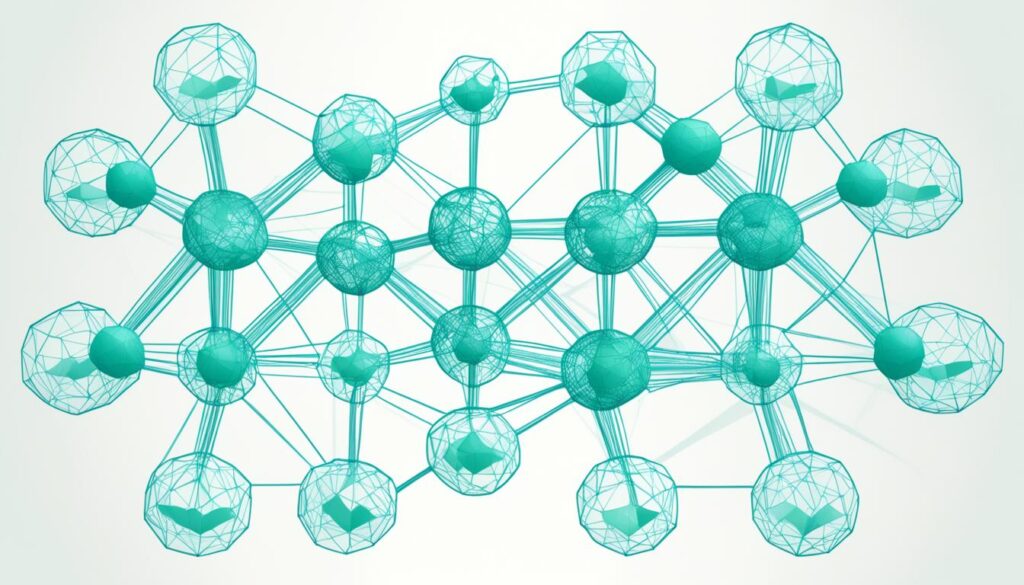Welcome to the future of the internet! Web 3.0 is set to revolutionize the way we interact online by harnessing the power of emerging technologies like AI, blockchain, and IoT. This new generation of the internet aims to provide enhanced security, privacy, and personalized experiences for users.
Blockchain technology, a key component of Web 3.0, plays a crucial role in ensuring the security and transparency of this next-gen internet. By leveraging decentralized databases and cryptographic algorithms, blockchain provides a robust foundation for secure online interactions.
Key Takeaways:
- Web 3.0 is the next generation of the internet, powered by technologies like AI, blockchain, and IoT.
- Blockchain technology ensures the security and transparency of Web 3.0.
- Web 3.0 offers more secure and private online experiences and personalized content.
- Decentralized databases and cryptographic algorithms in blockchain enhance internet security.
- Web 3.0 introduces new security risks, but security-by-design principles can mitigate these risks.
What is Web 3.0 and How Does It Work?
Web 3.0 represents the evolution of the internet, transforming it from a static, text-based platform into a dynamic and intelligent ecosystem. This next generation of the web harnesses the power of technologies such as Artificial Intelligence (AI), blockchain, and the Internet of Things (IoT) to enhance user experiences and enable more natural and intuitive interactions.
Embracing Transparency with Web 3.0
One of the fundamental principles of Web 3.0 is transparency. Blockchain technology, as a key component of Web 3.0, plays a pivotal role in enhancing internet security and ensuring transparency of data. By utilizing blockchain, Web 3.0 ensures that data stored in decentralized databases cannot be altered or manipulated, increasing trust and security.
“Blockchain technology provides transparency and immutability to data.”
The Benefits of Blockchain in Internet Security
The integration of blockchain in Web 3.0 brings several benefits to internet security. First and foremost, the decentralized nature of blockchain ensures that there is no single point of failure, making it highly resilient to cyber attacks. Additionally, the immutability of data recorded on the blockchain prevents unauthorized modifications and tampering.
The transparent nature of blockchain further enhances security by providing visibility into data transactions. Every entry on the blockchain is recorded and verified by multiple participants, creating an audit trail that can be accessed and verified by anyone, enhancing trust and accountability.
Visualizing Web 3.0 with Blockchain

Web 3.0, powered by blockchain technology, will revolutionize the online landscape by fostering transparency, security, and trust. Blockchain ensures that data stored in decentralized databases is immutable and transparent, providing a solid foundation for the secure and trustworthy interactions that define Web 3.0.
As Web 3.0 continues to evolve, users can look forward to a more seamless, connected, and secure online experience, enabling them to harness the full potential of emerging technologies.
The Security Implications of Web 3.0
Web 3.0, with its decentralized data architecture, brings new security considerations that must be addressed. While the potential for data breaches increases, blockchain technology emerges as a powerful solution to enhance internet security. By leveraging blockchain, Web 3.0 can provide a safer online experience for users.
One of the key security features of Web 3.0 is the use of smart contracts and decentralized applications (dApps). These technologies offer privacy, freedom from censorship, and flexible development options. With smart contracts, users can engage in secure and transparent transactions without intermediaries, ensuring the integrity of the process.
“The incorporation of blockchain technology in Web 3.0 brings enhanced security and transparency to the internet, offering a safer online environment for users.”
However, as Web 3.0 evolves, new attack vectors have emerged. Smart contract logic hacks and flash loan attacks pose significant risks to the security of Web 3.0 platforms. It is crucial to adopt security-by-design principles and implement attack prevention techniques to mitigate these risks.
The Role of Blockchain in Web 3.0 Security
Blockchain technology plays a vital role in securing Web 3.0. Its decentralized and immutable nature ensures that data stored on the blockchain cannot be altered or manipulated, providing a trustworthy foundation for internet security.
Incorporating blockchain into Web 3.0 solutions enables enhanced security measures such as:
- Decentralization: Distributing data across a network of nodes reduces the vulnerability of a single point of failure, making it harder for attackers to compromise the system.
- Transparency: The transparent nature of blockchain allows users to verify and audit transactions, ensuring the integrity of the data and reducing the potential for fraud.
- Immutable Records: Blockchain’s immutability ensures that once a transaction or piece of data is recorded, it cannot be altered or tampered with.
To effectively enhance internet security with Web 3.0 and blockchain, it is crucial to choose the right type of blockchain that suits the specific security requirements and implement robust security protocols. Additionally, continuous monitoring, prompt response to vulnerabilities, and regular security audits are essential to maintaining a safe online environment.

Internet Security Solutions with Blockchain
Blockchain technology offers a range of solutions to enhance internet security in the Web 3.0 era. Some of these solutions include:
- Secure Data Storage: Decentralized storage solutions powered by blockchain technology safeguard sensitive data from unauthorized access, ensuring privacy and security.
- Identity Management: Blockchain-based identity management systems enable individuals to control and secure their digital identities, reducing the risk of identity theft and fraud.
- Secure Transactions: Blockchain ensures the integrity and confidentiality of transactions by leveraging encryption and smart contract technology, reducing the risk of data breaches and fraud.
- Cybersecurity Audits: Blockchain can be used to create immutable records of cybersecurity audits and compliance checks, providing a transparent and verifiable history of security measures taken.
By leveraging the power of blockchain technology, Web 3.0 can pave the way for a safer and more secure internet ecosystem. The incorporation of blockchain in Web 3.0 enables enhanced security features, ensuring the privacy, integrity, and trustworthiness of online interactions.
Privacy and Compliance Challenges in Web 3.0
Web 3.0 introduces new challenges in ensuring data reliability, confidentiality, and privacy. With decentralized data management, there is an increased potential for misinformation and security issues. The accuracy and authenticity of data published on and off the blockchain become crucial for maintaining trust and security in the digital world.
Decentralized IDs, a key feature of Web 3.0, present additional challenges to existing data protection regulations. While anonymity improves privacy, it raises questions of accountability and liability. Striking the right balance between privacy and compliance becomes paramount to navigate this evolving landscape.
“In the era of Web 3.0, securing the internet with blockchain technology is crucial for protecting sensitive data and preserving individual privacy. We need to adopt measures that ensure data validation, encryption, and compliance with regulations to address the privacy and compliance challenges.”
To tackle these challenges and secure the internet with Web 3.0 and blockchain, several measures should be implemented:
- Data Validation: Implementing robust mechanisms to verify the accuracy and authenticity of data published on the blockchain and related decentralized applications.
- Encryption: Employing strong encryption techniques to protect sensitive data, ensuring confidentiality and integrity throughout its lifecycle.
- Compliance with Regulations: Adhering to data protection and privacy regulations to respect user rights and foster trust in the Web 3.0 ecosystem.
- Decentralized Identity Solutions: Developing decentralized identity solutions that enable users to maintain control over their personal information while meeting compliance requirements.
Addressing these privacy and compliance challenges will be essential in harnessing the full potential of Web 3.0. By implementing secure practices and leveraging blockchain technology’s inherent security features, we can build a safer and more privacy-focused internet for the future.

Privacy and Compliance Challenges in Web 3.0
| Challenges | Solutions |
|---|---|
| Data reliability and confidentiality | Data validation mechanisms and strong encryption techniques |
| Authenticity of data published on and off the blockchain | Robust verification processes and adherence to regulations |
| Decentralized IDs and data protection regulations | Developing decentralized identity solutions and achieving compliance |
| Privacy and accountability concerns | Privacy-centric approaches while ensuring compliance and accountability |
Benefits and Opportunities of Web 3.0 Development
Web 3.0 development offers numerous benefits and opportunities for individuals and businesses alike. By harnessing the power of blockchain technology, Web 3.0 revolutionizes the way we interact with the internet, providing enhanced security, transparency, and digital ownership.
- Efficient and Cost-Effective Transactions: With the use of smart contracts, Web 3.0 enables efficient and cost-effective business transactions. By eliminating intermediaries, such as banks or brokers, transactions can be executed faster and at a lower cost, resulting in increased productivity and profitability.
- Enhanced Security and Transparency: Decentralized storage and encryption techniques employed in Web 3.0 ensure the security and transparency of data and transactions. Blockchain technology guarantees the immutability and integrity of data, making it highly resistant to hacking or tampering.
- Data Control and Ownership: Web 3.0 empowers individuals to have greater control over their data, digital assets, and digital identity. Through decentralized platforms, users can manage their personal information and decide who has access to it, granting them ownership over their online presence.
- Inclusivity and Democracy: Web 3.0 promotes inclusivity and democracy through decentralized social networks, where users have a say in the governance and operations of the platform. This decentralized approach fosters innovation, diversity, and community-driven decision-making.
- Opportunities for Innovation: Web 3.0 unleashes new opportunities for innovation in various fields. Decentralized finance (DeFi) allows for financial services that are accessible to everyone, regardless of their location or socioeconomic status. Decentralized governance transforms traditional hierarchical systems into transparent and collaborative networks.
“Web 3.0 unlocks a world of possibilities, where individuals are in control of their own data, transactions are fast and secure, and innovation knows no bounds.” – Web3 Solutions
Web 3.0 also enables new forms of digital ownership and value creation. Non-Fungible Tokens (NFTs) provide a way to represent unique digital assets, such as artwork or collectibles, ensuring provenance and scarcity. Additionally, blockchain-based donation platforms enable transparent and auditable charitable contributions.

| Benefit | Description |
|---|---|
| Efficient Transactions | Smart contracts eliminate intermediaries, resulting in faster and cost-effective transactions. |
| Enhanced Security and Transparency | Decentralized storage and encryption techniques ensure secure and transparent data handling. |
| Data Control and Ownership | Web 3.0 empowers individuals to have control over their data and digital assets. |
| Inclusivity and Democracy | Decentralized social networks promote inclusivity, diversity, and community-driven decision-making. |
| Opportunities for Innovation | Decentralized finance and governance unleash innovation in various fields. |
Conclusion
Web 3.0, powered by blockchain technology, has the potential to revolutionize the internet by offering a more secure, transparent, and inclusive online experience. With the rise of emerging technologies such as AI, blockchain, and IoT, Web 3.0 provides a solid foundation for a safer internet.
While Web 3.0 introduces new security and privacy challenges, adopting security-by-design principles and staying informed about the latest advancements can help mitigate risks. Incorporating blockchain technology in Web 3.0 development plays a vital role in ensuring data integrity, immutability, and decentralized control.
Web 3.0 development brings numerous benefits and opportunities, empowering individuals and communities while transforming industries. By embracing decentralized systems, Web 3.0 enables individuals to have greater control over their data, digital assets, and digital identity. It promotes transparency, self-governance, and innovation.
As we continue to witness the evolution of Web 3.0, it is crucial to prioritize security, transparency, and innovation to shape the future of the internet. By harnessing the power of blockchain technology and adhering to best practices, we can build a safer internet where individuals can thrive, trust is strengthened, and a new era of online experiences unfolds.
FAQ
What is Web 3.0?
Web 3.0 is the next generation of the internet, designed to be more secure and interactive. It leverages technologies like AI, blockchain, and IoT to provide a more personalized online experience and enable users to interact with the web in a more natural and intuitive way.
How does blockchain enhance internet security in Web 3.0?
Blockchain technology plays a crucial role in enhancing internet security in Web 3.0. It provides transparency and immutability to data, ensuring that information stored in decentralized databases cannot be altered or manipulated. This increases trust and security in online transactions and interactions.
What are the security implications of Web 3.0?
Web 3.0 introduces new security risks due to the decentralization of data, but blockchain technology offers solutions to enhance internet security. Smart contracts and decentralized applications (dApps) ensure privacy, freedom from censorship, and flexible development. However, new attack types like smart contract logic hacks and flash loan attacks have emerged, requiring the adoption of security-by-design principles and attack prevention techniques.
What are the privacy and compliance challenges in Web 3.0?
Web 3.0 raises concerns about data reliability, confidentiality, and privacy. Decentralized data management can lead to misinformation and security issues. The accuracy and authenticity of data published on and off the blockchain become crucial. Web 3.0 also introduces decentralized IDs that pose challenges to existing data protection regulations. Measures such as data validation, encryption, and compliance with regulations need to be implemented to address these challenges.
What are the benefits and opportunities of Web 3.0 development?
Web 3.0 development offers numerous benefits and opportunities. Smart contracts enable efficient and cost-effective business transactions by eliminating intermediaries. Decentralized storage and encryption techniques ensure the security and transparency of data and transactions. Web 3.0 empowers individuals to have greater control over their data, digital assets, and digital identity. It also promotes inclusivity, democracy, and innovation through decentralized social networks, decentralized finance, and decentralized governance. Web 3.0 enables new forms of digital ownership and value through NFTs and blockchain-based donation platforms.
How can Web 3.0 and blockchain contribute to a safer internet?
Web 3.0, powered by blockchain technology, has the potential to revolutionize the internet by offering a more secure and transparent online experience. While it introduces new security and privacy challenges, adopting security-by-design principles, using the right type of blockchain, and staying informed can help mitigate risks. Prioritizing security, transparency, and innovation can shape the future of the internet and create a safer online environment.








